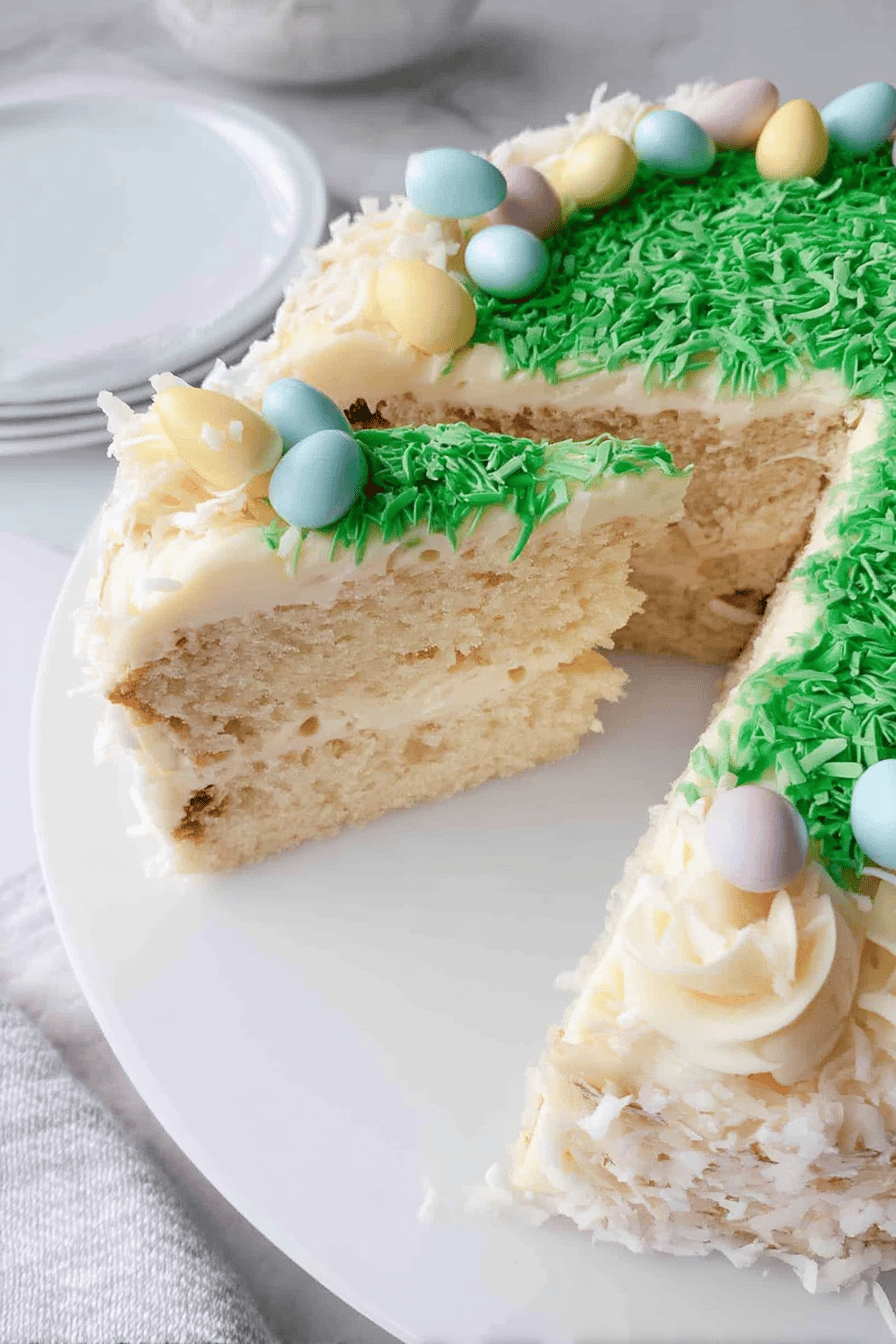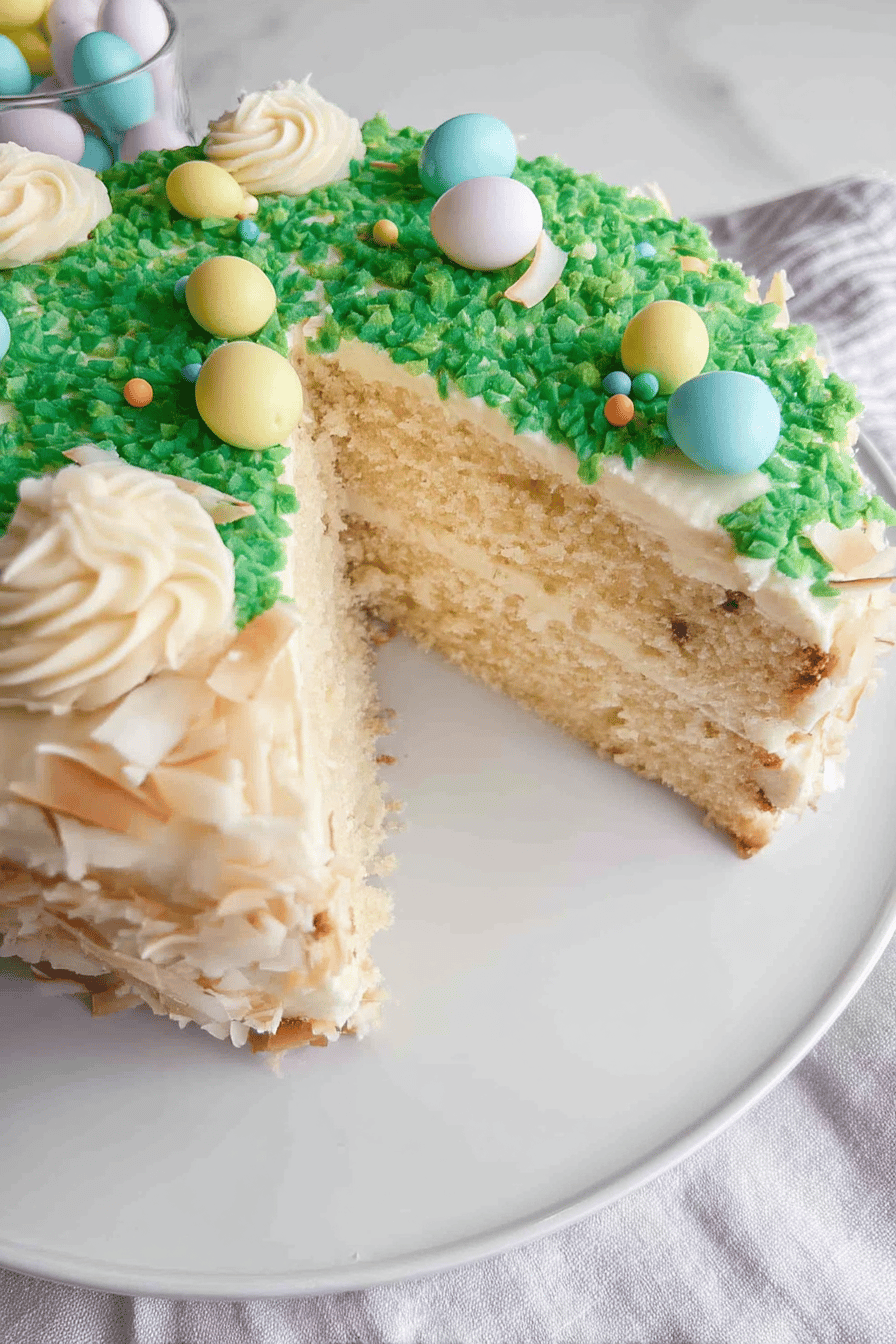Why You’ll Love This Coconut Easter Cake
- Ease of preparation: This coconut Easter cake recipe is delightfully simple, requiring minimal ingredients and straightforward steps that can be completed quickly. Whether you’re a beginner or an experienced baker, the recipe’s clear instructions and manageable baking time (about an hour) let you spend less time fussing and more time enjoying. Plus, using a Bundt pan makes it easy to achieve a show-stopping presentation without complicated assembly.
- Health benefits: This cake includes wholesome ingredients such as coconut, which provides healthy fats and dietary fiber, along with refreshing lemon zest and juice that supply vitamin C. Using sour cream or yogurt adds protein and probiotics for a nourishing twist. The recipe balances indulgence with mindful nutrition, making it a festive yet wholesome treat for Easter or springtime gatherings (benefits of coconut in baking).
- Versatility: Easily adapted to suit various dietary needs, this coconut Easter cake allows ingredient substitutions for vegan, gluten-free, or low-calorie versions without sacrificing its moist, dense crumb or rich flavors. This flexibility ensures every guest can enjoy it, no matter their dietary preferences or restrictions.
- Distinctive flavor: The combination of luscious coconut flavor, bright lemon notes, and a creamy tang from the lemon cream cheese frosting makes this cake irresistibly flavorful. The shredded coconut “feathers” decorating the top add texture and whimsy, while candy-coated chocolate eggs bring festive charm a true centerpiece for Easter celebrations.
Jump To
- 1. Why You’ll Love This Coconut Easter Cake
- 2. Essential Ingredients for Coconut Easter Cake
- 3. How to Prepare the Perfect Coconut Easter Cake: Step-by-Step Guide
- 4. Dietary Substitutions to Customize Your Coconut Easter Cake
- 5. Mastering Coconut Easter Cake: Advanced Tips and Variations
- 6. How to Store Coconut Easter Cake: Best Practices
- 7. FAQs: Frequently Asked Questions About Coconut Easter Cake
- 8. coconut easter cake
Essential Ingredients for Coconut Easter Cake
- 3 cups (360g) cake flour (or all-purpose flour as a substitute) – provides the tender, dense structure characteristic of pound cakes
- 3 teaspoons baking powder – helps the cake rise to a fluffy yet sturdy texture
- 1/2 teaspoon baking soda – contributes to leavening and tender crumb
- 1/2 teaspoon salt – balances and enhances the overall flavor
- 1 cup (227g) unsalted butter, softened – adds moisture, flavor, and richness
- 1 3/4 cups (350g) granulated sugar – sweetens and helps develop a golden crust
- 1 heaping tablespoon lemon zest – imparts fresh citrus aroma and brightness
- 1/2 cup (120ml) vegetable oil – keeps the cake moist and tender
- 5 large eggs, room temperature – binds ingredients and adds richness
- 2 teaspoons pure vanilla extract – deepens flavor complexity
- 1 teaspoon coconut extract – enhances the coconut flavor throughout the cake
- 1/2 cup (120g) full-fat sour cream or plain yogurt, room temperature – adds moisture and a subtle tang
- 2/3 cup (160ml) whole milk, room temperature (can be substituted with coconut milk for extra coconut flavor) – moistens the batter
- 1/4 cup (60ml) fresh lemon juice – balances sweetness and adds zing
- 1 cup (80g) sweetened shredded or flaked coconut – boosts texture and coconut intensity in the batter
Lemon Cream Cheese Frosting
- 8 ounces (227g) full-fat cream cheese, softened – creates a creamy, tangy frosting
- 1/4 cup (57g) unsalted butter, softened – adds richness and smooth consistency
- 2 cups (250g) confectioners’ sugar – sweetens and thickens the frosting
- 1 to 2 tablespoons fresh lemon juice – brightens and balances sweetness
- 1 teaspoon pure vanilla extract – rounds out flavor
Topping
- 1 1/2 cups (120g) sweetened shredded coconut (toasted optionally for color & crunch) – decorates the cake with “feathers” texture
- 1 to 2 cups candy-coated chocolate eggs or colorful Easter-themed candies – festive decoration resembling a bird’s nest
Special Dietary Options
- Vegan: Substitute eggs with flaxseed meal or blends, use plant-based sour cream (like coconut yogurt), and replace butter with vegan margarine or coconut oil.
- Gluten-free: Replace cake flour with a high-quality gluten-free all-purpose flour blend to maintain texture.
- Low-calorie: Use sugar substitutes (e.g., erythritol), reduce oil, and substitute sour cream with low-fat yogurt or applesauce.
How to Prepare the Perfect Coconut Easter Cake: Step-by-Step Guide
First Step: Preheat and Prepare
Preheat your oven to 350°F (175°C) and generously grease a Bundt pan to prevent sticking. Gather all ingredients and allow refrigerated items such as eggs, sour cream, and milk to come to room temperature for even mixing.
Second Step: Combine Dry Ingredients
In a medium bowl, whisk together 3 cups cake flour, 3 teaspoons baking powder, 1/2 teaspoon baking soda, and 1/2 teaspoon salt to evenly distribute leavening agents and salt.
Third Step: Cream Butter, Sugar, and Lemon Zest
In a large bowl, beat 1 cup softened unsalted butter on high speed until fluffy (about 1 minute). Add 1 3/4 cups granulated sugar and 1 heaping tablespoon lemon zest and continue beating for 3-4 minutes until the mixture is light and airy. Add 1/2 cup vegetable oil and mix on medium speed to combine.
Fourth Step: Add Eggs and Flavorings
On low speed, add 5 eggs one at a time, ensuring each is fully incorporated before adding the next. Then mix in 2 teaspoons vanilla extract and 1 teaspoon coconut extract for flavor depth.
Fifth Step: Alternate Dry Ingredients and Liquids
Whisk together 1/4 cup fresh lemon juice and 2/3 cup whole milk (or coconut milk for extra coconut flavor). Alternately add the dry ingredient mixture and the lemon-milk mixture to the batter in three parts on low speed. Mix just until combined after each addition to avoid overworking the batter.
Sixth Step: Fold in Coconut
Gently fold in 1 cup sweetened shredded or flaked coconut to maintain a tender, light texture without overmixing.
Seventh Step: Bake the Cake
Pour the batter evenly into the prepared Bundt pan. Bake for 55 to 65 minutes until the edges are golden and a toothpick inserted near the center comes out clean. Cover with foil if browning too fast. Once done, cool the cake in the pan for 2 hours before inverting onto a cake stand to cool completely.
Final Step: Frost and Decorate
Beat 8 ounces softened cream cheese and 1/4 cup softened butter on medium until smooth (about 2 minutes). Gradually add 2 cups confectioners’ sugar, 1-2 tablespoons fresh lemon juice, and 1 teaspoon vanilla extract on low speed. Increase speed and beat for 3 minutes until fluffy. Spread evenly over the cooled cake. Press remaining shredded coconut onto frosting for a feather-like texture. Optionally, toast coconut flakes at 300°F (150°C) for 6-8 minutes for color and crunch. Fill the center nest with candy-coated chocolate eggs and serve.
Using room temperature ingredients and gentle mixing ensures a tender, moist crumb with a luscious coconut-lemon flavor perfect for festive celebrations.
For detailed guidance on Bundt cake baking techniques, visit How to Make Perfect Bundt Cake.
Dietary Substitutions to Customize Your Coconut Easter Cake
Protein and Main Component Alternatives
- Replace eggs with flaxseed meal mixed with water or applesauce for vegan bonding alternatives.
- Use silken tofu blended smoothly for added moisture and protein in vegan recipes.
Vegetable, Sauce, and Seasoning Modifications
- Add natural extracts like vanilla or almond to complement the coconut flavor.
- Adjust sweetness using natural sweeteners such as honey or maple syrup for a different flavor profile.
- Try warm spices such as cinnamon or nutmeg to enrich the flavor complexity without overwhelming.
Mastering Coconut Easter Cake: Advanced Tips and Variations
- Pro cooking techniques: Use room temperature ingredients to promote even mixing and light texture. Sift dry ingredients properly to remove lumps and improve fluffiness.
- Flavor variations: Add lime zest, crushed pineapple chunks, or toasted almonds for refreshing twists on the classic coconut Easter cake.
- Presentation tips: Garnish with whipped coconut cream and toasted coconut flakes for elegant texture. Use festive Easter-themed toppers for visual charm.
- Make-ahead options: Prepare batter the night before and refrigerate to save time. Assemble and bake fresh on serving day to preserve freshness and quality.
How to Store Coconut Easter Cake: Best Practices
| Storage Method | Details | Duration |
|---|---|---|
| Refrigeration | Store in an airtight container at room temperature for up to 2 days or refrigerate to extend freshness up to 5 days. Cover well to prevent drying. | 2–5 days |
| Freezing | Wrap cake tightly in plastic wrap and aluminum foil before freezing. Store up to 3 months. Thaw overnight in the refrigerator before frosting. | Up to 3 months |
| Reheating | Warm slices gently in a microwave or low-temperature oven to restore softness without drying out. | Immediate consumption after reheating |
| Meal Prep | Cut into portions before storing to facilitate quick serving and maintain quality during batch preparation. | Varies |

FAQs: Frequently Asked Questions About Coconut Easter Cake
How should I store coconut Easter cake if I bake it ahead of time?
If you bake the coconut Easter cake up to one day in advance, store it covered in the refrigerator to keep it fresh. Before serving, let the cake sit at room temperature for about 30 minutes to soften. For longer storage, freeze the unfrosted cake, then thaw it overnight in the refrigerator before frosting and serving.
Can I use coconut oil instead of vegetable oil in this coconut cake recipe?
Yes, coconut oil can replace vegetable oil in the same quantity. Using coconut oil will add a subtle coconut flavor and may slightly affect the cake’s texture, making it moist and tender.
What can I do if I want to make a layered coconut Easter cake using this recipe?
This coconut cake recipe is designed for a Bundt pan and may not be ideal for layers. For a layered cake, it’s better to use a coconut cake recipe specifically written for 9-inch cake pans and thicker frosting like lemon cream cheese frosting, which works well as a filling and outer layer.
Can I substitute lime juice and zest for lemon in the frosting or cake?
Yes, lime juice and zest can be used in place of lemon in equal amounts. This substitution gives the cake a fresh citrus twist that pairs nicely with the coconut flavor.
How should I adjust baking coconut cake if I’m at high altitude?
At high altitudes, you can add about 1/4 cup more flour and 1/4 teaspoon baking powder, and reduce the oven temperature by 25°F. These changes help prevent the cake from rising too quickly and collapsing, but results may vary depending on your specific altitude.

coconut easter cake
- Total Time: 4 hours
- Yield: 10-12 servings
- Diet: Vegetarian
Description
🥥 Coconut Easter Cake offers a moist, flavorful treat adorned with a refreshing lemon cream cheese frosting and festive coconut decorations.
🌼 Perfect for spring celebrations, this cake combines tropical coconut and bright lemon to delight your taste buds and impress your guests.
Ingredients
– 3 cups cake flour
– 3 teaspoons baking powder
– 1/2 teaspoon baking soda
– 1/2 teaspoon salt
– 1 cup unsalted butter, softened
– 1 3/4 cups granulated sugar
– 1 heaping tablespoon lemon zest
– 1/2 cup vegetable oil
– 5 large eggs
– 2 teaspoons pure vanilla extract
– 1 teaspoon coconut extract
– 1/2 cup full-fat sour cream or plain yogurt
– 2/3 cup whole milk
– 1/4 cup fresh lemon juice
– 1 cup sweetened shredded or flaked coconut
– 8 ounces full-fat cream cheese, softened
– 1/4 cup unsalted butter, softened
– 2 cups confectioners’ sugar
– 1 to 2 tablespoons fresh lemon juice
– 1 teaspoon pure vanilla extract
– 1 1/2 cups sweetened shredded coconut
– 1 to 2 cups candy-coated chocolate eggs or colorful Easter-themed candies
Instructions
First Step: Preheat your oven to 350°F (175°C) and generously grease a Bundt pan to prevent sticking. Gather all ingredients and allow refrigerated items such as eggs, sour cream, and milk to come to room temperature for even mixing.
Second Step: In a medium bowl, whisk together 3 cups cake flour, 3 teaspoons baking powder, 1/2 teaspoon baking soda, and 1/2 teaspoon salt to evenly distribute leavening agents and salt.
Third Step: In a large bowl, beat 1 cup softened unsalted butter on high speed until fluffy (about 1 minute). Add 1 3/4 cups granulated sugar and 1 heaping tablespoon lemon zest and continue beating for 3-4 minutes until the mixture is light and airy. Add 1/2 cup vegetable oil and mix on medium speed to combine.
Fourth Step: On low speed, add 5 eggs one at a time, ensuring each is fully incorporated before adding the next. Then mix in 2 teaspoons vanilla extract and 1 teaspoon coconut extract for flavor depth.
Fifth Step: Whisk together 1/4 cup fresh lemon juice and 2/3 cup whole milk (or coconut milk for extra coconut flavor). Alternately add the dry ingredient mixture and the lemon-milk mixture to the batter in three parts on low speed. Mix just until combined after each addition to avoid overworking the batter.
Sixth Step: Gently fold in 1 cup sweetened shredded or flaked coconut to maintain a tender, light texture without overmixing.
Seventh Step: Pour the batter evenly into the prepared Bundt pan. Bake for 55 to 65 minutes until the edges are golden and a toothpick inserted near the center comes out clean. Cover with foil if browning too fast. Once done, cool the cake in the pan for 2 hours before inverting onto a cake stand to cool completely.
Final Step: Beat 8 ounces softened cream cheese and 1/4 cup softened butter on medium until smooth (about 2 minutes). Gradually add 2 cups confectioners’ sugar, 1-2 tablespoons fresh lemon juice, and 1 teaspoon vanilla extract on low speed. Increase speed and beat for 3 minutes until fluffy. Spread evenly over the cooled cake. Press remaining shredded coconut onto frosting for a feather-like texture. Optionally, toast coconut flakes at 300°F (150°C) for 6-8 minutes for color and crunch. Fill the center nest with candy-coated chocolate eggs and serve.
Notes
🌡️ Use room temperature ingredients to achieve even mixing and the best texture.
🥥 Substitute whole milk with coconut milk and increase coconut extract for a stronger coconut flavor.
⏳ Bake in advance and store unfrosted for convenience; freeze for longer storage.
- Prep Time: 35 minutes
- Cooling Time: 2 hours
- Cook Time: 55-65 minutes
- Category: Dessert, Cake, Holiday
- Method: Baking
- Cuisine: American
Nutrition
- Serving Size: 1 slice
- Calories: 420 kcal
- Sugar: 35 g
- Sodium: 220 mg
- Fat: 18 g
- Saturated Fat: 10 g
- Unsaturated Fat: 6 g
- Trans Fat: 0 g
- Carbohydrates: 55 g
- Fiber: 2 g
- Protein: 5 g
- Cholesterol: 65 mg
Keywords: coconut easter cake, lemon cream cheese frosting, shredded coconut cake, festive spring cake



This coconut cake was a hit at our Easter brunch! 🐰🥥 I sprinkled some toasted coconut flakes on top for a bit of crunch, and it added so much texture. Can’t wait to eat the leftovers with my morning coffee. ☕
★★★★★